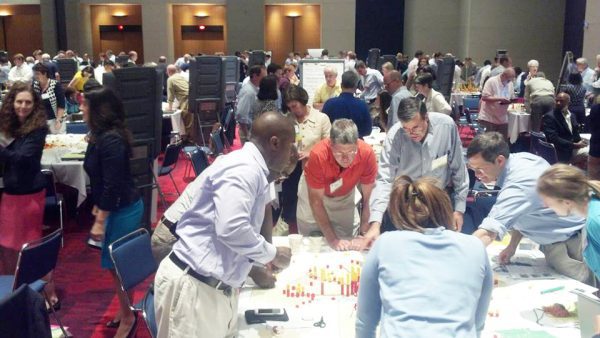Learning, again, why plans sometimes fail

You’d think I would have known better. After all, I’ve been writing about growth since before they called it Smart Growth, and I’m still writing about it now that it’s “resiliency,” or “sustainable growth” or whatever the next term is. I can’t count how many times I’ve explained that when you decide where you want urban growth to go, you must also decide where you don’t want it to go.
That’s why last week’s regional planning exercise was an eye-opener. I learned – or rather, learned again – some key lessons:
- Real life doesn’t always work the way you think it should.
- The general public doesn’t think nearly as much about these issues as we like to assume they do.
The exercise was RealityCheck2050, part of a multi-year, regional planning project called CONNECT Our Future that’s looking at the 14-county, two-state Charlotte region. RealityCheck, organized by the Charlotte chapter of the Urban Land Institute, hosted 400 people – among them some 30 elected officials.
We started by listening to speakers, including Ed McMahon of the Urban Land Institute, whose inspiring talk included this line – one I’ve heard so often I groaned: “Trying to cure congestion by building more lanes is like trying to cure obesity by lengthening your belt.”
Yet many in the audience laughed. People Tweeted it to their followers. Lesson No. 1: Sometimes city planner types forget other people are not immersed in this subject.
Then we began a game-like exercise at tables fitted out with Legos and a giant regional map. We were told that by 2050 the region of 2.4 million is expected to grow by 1.8 million people and add 863,000 jobs. Each table had to stack hundreds of red and yellow Legos where we thought jobs and housing should go. We could mark out new transit lines with orange yarn, new highways with purple, and green spaces with green yarn.
Others at my table were a construction company official, a human services worker, a local school system employee, an elected official who owns land near a proposed but controversial highway, and a planner working in municipal government, but not in planning.
As instructed, we agreed on our shared vision for growth: Concentrate new development where infrastructure already exists. Cluster development near transit lines. Protect water quality. Protect farms and open spaces.
Then we began rapidly and somewhat haphazardly placing Legos and yarn. I stacked jobs and housing in downtown Charlotte. Across the table, the elected official began putting housing and jobs in the now-rural area near his property. The human services worker and school employee, standing near him, started following his lead. Next thing you know a rural farming area was coated with low-density housing and scattered jobs.

I don’t think they were deliberately ignoring our goal to protect farmland. I think they were unsure of what to do – the instruction booklet was hard to follow – and were copying the guy next to them, something most of us do in similar situations.
Around this time the planner at our table had to leave. The table moderators, two more planners, kept quiet and let us work. I began moving the Legos plopped in rural areas over to existing towns and along existing transportation corridors.
It took a while to place hundreds of Legos around the region. Only then did we look at our work and say, “Now, what about green space?”
We tried to draw in parks and farm areas with green yarn but kept accidentally knocking down the Lego towers. (It didn’t help that there was a wrinkle on our map, creating a sort of earthquake fault line for stacked Legos.)
We also didn’t add any new transit lines until near the end. That, too, involved clumsily knocking down Legos.
It occurred to me that our experience was a lot like real life.
Unless you first decide where not to grow, trying to retrofit a built-out area with parks and natural areas is difficult, clumsy and expensive. That’s true, too, with a transit line.
I knew those things. But building – at least, playing with Legos – is more fun than tediously laying out yarn. In our table’s zeal to play developer, we neglected basic planning. And my table mates had not stopped to think that putting houses and jobs in the countryside did not support what they said they valued: protecting rural areas and water, and clustering development near infrastructure.
By not understanding the effect of the development, they inadvertently undercut their larger goals.
Which is exactly how so many metro regions, including this one, end up being built out. People don’t stop to plan because, well, it’s less fun than building. And most of us, including developers, tend to copy what others do, because that’s what we’re used to seeing.
It’s easy for those of us who do pay attention to planning and growth to forget that most people in most places don’t.
Which means it’s easy for us to forget that although we’ve heard the same messages over and over and over until we’re sick of it, other people are only then starting to hear them: If you want to preserve open spaces you have to decide, from the start, where you won’t grow. If you want to cluster development where services already exist, you can’t allow development where services don’t exist (also known as “Growth Follows the Pipe”). And yes, curing congestion by building more lanes is like trying to cure obesity by getting a longer belt. That last slogan, at least, is likely to get a good chuckle from the audience.
Mary Newsom is associate director of urban and regional affairs at the UNC Charlotte Urban Institute, and directs PlanCharlotte.org. Views expressed here do not necessarily represent the views of the UNC Charlotte Urban Institute or the University of North Carolina at Charlotte.